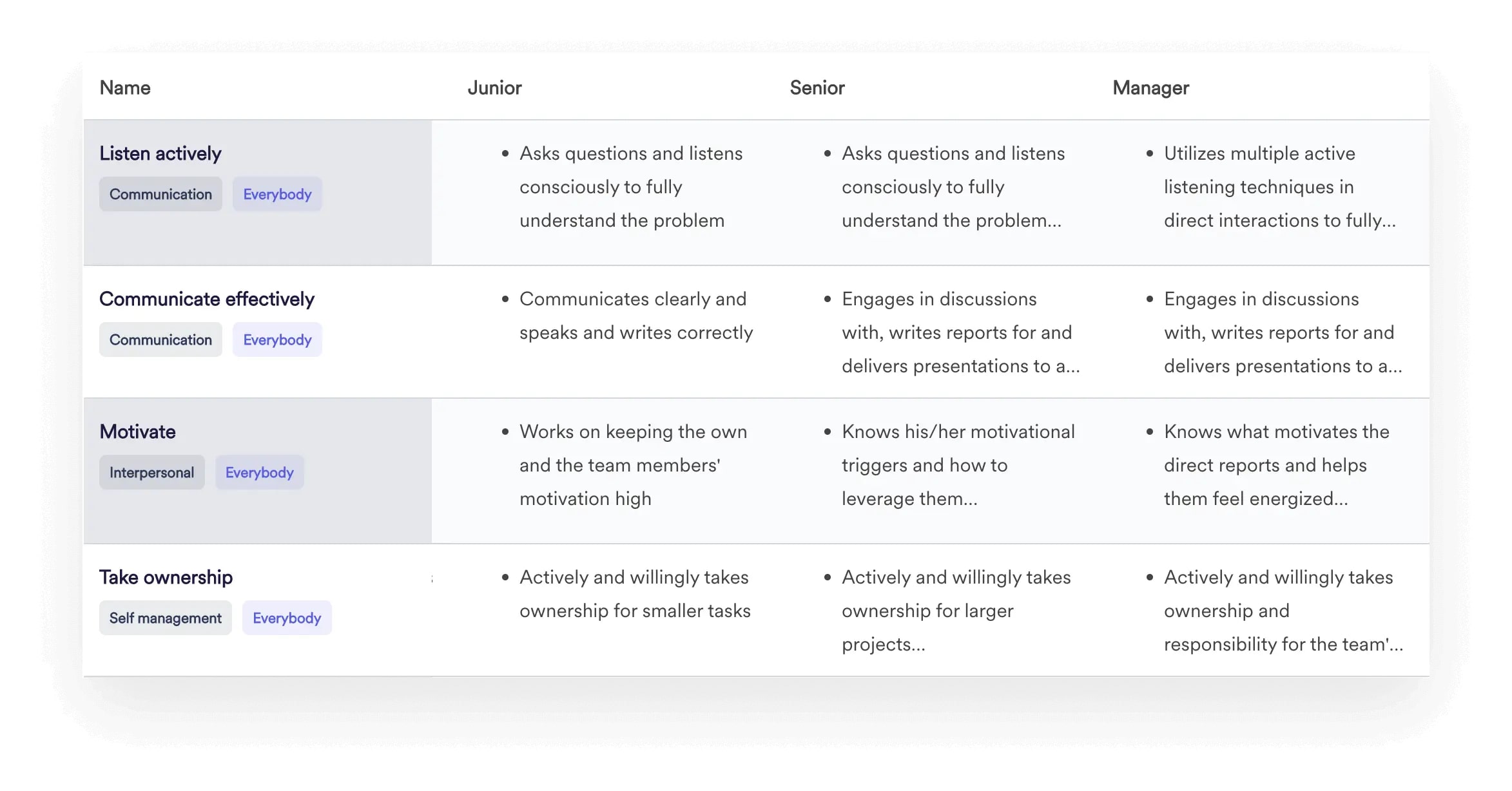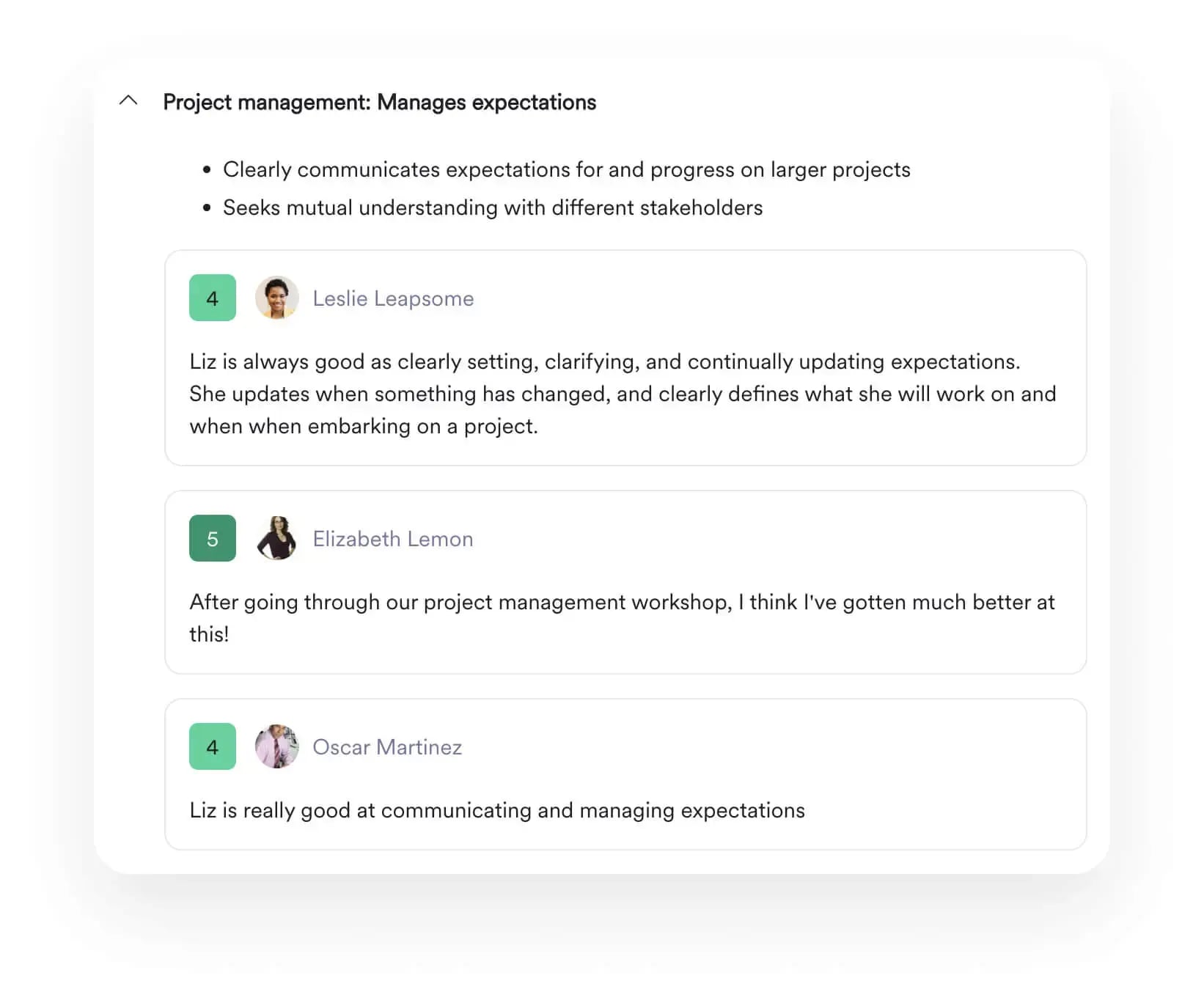Performance appraisal form [template + writing tips]
![Performance appraisal form [template + writing tips]](jpg/62bf11cd8ccff97e45a731a1_01_an%20interview%20style%20setting%20with%20a%20man%20and%20a%20woman.jpg)
Performance appraisals are crucial for businesses looking to improve performance and boost employee development. They give staff a clearer understanding of the competencies they need to develop and enable managers to give tangible guidance on how to grow as professionals.
Still, many companies struggle to design a performance appraisal that’s streamlined, constructive, and aligned with team members’ needs. According to our research, 32% of employees say they’re not quite satisfied — or actively dissatisfied — with their company’s performance review processes (1).
Why are they unhappy? It’s likely because professionals appreciate the feedback they receive in appraisals and feel they need more: In the same report, 79% of employees said constructive feedback makes them more productive, and 52% of respondents disclosed wanting more frequent reviews.
A reliable performance appraisal form can make your evaluation cycles more development-oriented and frictionless. With the right form and process, you can run performance reviews more frequently and keep employees engaged in their professional growth process.
That’s why, in this post, we’ll:
- Summarize what a good appraisal form is and why you need one
- Explain how to create effective performance appraisal forms that you can tailor to each employee
- Provide a performance appraisal form template you can adapt according to your needs
*Leapsome Workforce Trends Report, 2023
👊 Make performance appraisals more impactful and development-driven
Leapsome Reviews makes the evaluation process super-efficient with customizable templates and automated review cycles.
👉 Learn more
What is an employee performance appraisal form?
An employee appraisal form is a centralized document that lets managers and team members evaluate an individual’s current competency levels, rating the direct reports’ skills to help them grow and providing actionable feedback for their development. Appraisal forms are key to making the performance management cycle more streamlined and adaptable.
Performance appraisal forms can combine employee self-assessments and feedback from managers, peers, reports, customers, and external partners. They allow managers and HR teams to identify skill gaps and, when linked to a dedicated competency framework for every department, offer a roadmap for improvement and career growth.
Insights from employee appraisal forms can also help managers track development, provide information about hiring needs, make more unbiased compensation decisions, and inform training budget allocation — all while showing your people that your organization supports their growth.
Well-run appraisals can boost staff engagement and productivity
How to create an effective employee performance appraisal form
The best performance appraisal formats are customizable to fit various employee roles, abilities, and areas of improvement. Taking an individualized approach while still following best practices tells team members that leadership has a personal interest in their development, boosting their sense of belonging and engagement.
Create a centralized appraisal document
Your appraisal process should live on an easily distributable document, editable template, or spreadsheet — whatever system works best for your company. Not only does that make it easier for everyone to access, but it also allows you to implement changes quickly based on employee feedback.
Ideally, we suggest using a platform like Leapsome Reviews to create, customize, and store your centralized appraisal template.
With Leapsome, you can determine who can use your appraisal template and who participates in regular evaluations. Then, you can assign timelines and automate future reviews, setting up notifications and reminders to keep everyone in the loop.

Include a rating rubric
Including a numeric rating rubric for each skill or category enables both staff and managers to track performance at a glance. For example, your company might consider a team member’s “strengths” to be any skills receiving a score of three to five, while the employee’s “areas for improvement” would receive scores of two and below.
To allow for fairer assessments and more in-depth review analytics, you should make space for additional comments so everyone giving feedback has a chance to explain the context behind a given score.
We recommend a five-point scale to keep ratings simple, but you could also use a ten-point scale, letter grades, or even emojis if they suit your organization’s culture.
Outline employee achievements
An effective staff appraisal form should be highly customizable, allowing managers and other reviewers — peers and coworkers participating in the evaluation — to highlight the team member’s specific skills, strengths, and achievements.
Ensuring that your performance appraisal form highlights areas for improvement and achievements allows employees to both see how they’re doing and receive recognition for their strengths. This kind of multilevel feedback will boost engagement and motivation.
You can score employees on a set selection of skills outlined in your company’s competency framework, which is ideal for keeping appraisals consistent and preventing arbitrary metrics and biases from inhibiting the review process.

Outline areas for improvement
A solid performance appraisal document enables managers to highlight areas where employees may have room to grow while providing suggestions for improvement and action steps to take, such as more training. It’s also crucial for employees to have a space to self-reflect on areas where they’re struggling openly and without judgment.
We recommend keeping your language as positive as possible while still being transparent to avoid discouraging employees. Refer to “areas for improvement” or “opportunities for growth” rather than “weaknesses” to maintain motivation.
💡 Keep in mind: Strong performance appraisal forms offer all participants (including reviewees) space to leave scores and include comments for more context
What components should you include? Performance appraisal form examples
Your performance appraisal form can contain any questions relevant to your business, company values, and employees’ skills, responsibilities, or training needs. Here are some examples of different ways to set up these questions and assess employee development:
Assessing skills
An effective employee appraisal form focuses on a range of critical skills — which may include communication, motivation, critical thinking, results and delivery, innovation, and task ownership. Managers can score those competencies numerically; we recommend a five-point scale.
In the sample appraisal form below, you can see that the document includes space for both the manager’s assessment and the employee’s self-assessment. This allows managers and direct reports to understand performance from the other’s perspective, giving them a starting point for a deeper conversation around performance and development.

Including open-ended questions
Performance appraisal forms should also include open-ended questions that prompt more tailored responses. These questions can guide the reviewee and their manager on areas to focus on during the next review cycle.
Open-ended prompts also allow all reviewers to provide more context behind their scores, allowing team members to follow up with all review participants who have questions and comments.

Linking reviews with goal setting
Make reviews more actionable for team members by creating a specific space for reviewers and reviewees to suggest performance objectives. Including space to do so within your appraisal documents gives reviewees clear items to focus on for their future development.
However, reviewers shouldn’t suggest arbitrary performance goals, but should instead connect them to a set of specific, predefined competencies. Adhering to a set of approved, company-wide competencies helps keep suggestions for personal goals aligned with company objectives, enabling employees to develop in a direction that’s beneficial to their growth and to the organization at large. Thankfully, platforms like Leapsome can streamline this process. Our platform allows organizations to define core skills for every employee within a customizable competency framework that also links with performance reviews, goal-setting tools, and instant feedback features to keep employees motivated and moving forward professionally.
In suggesting these performance objectives, reviewers should remember that they aren’t automatically set in stone — managers and direct reports should revisit any suggested objectives during the performance review meeting and collaborate on ways to ensure they’re aligned with company, team, and personal goals.

🚀 Want to boost employee engagement, grow talent, and drive performance?
Leading teams use Leapsome’s integrated modules for conducting surveys, assessing employee performance, and creating learning pathways to do exactly that.
👉 Book a demo
Our downloadable appraisal template

Our free, downloadable performance appraisal template gives you access to a core list of best-practice questions for your performance reviews — including leadership assessments and 360° appraisals.
Example questions include:
- What do you consider to be your biggest achievement since your last review?
- What should you keep doing?
- What should you work more on (i.e., change, improve)?
- What do you consider to be your core strengths?
- What is your most important development goal, and what support do you need to further develop in your role?
Improve your employee appraisal process with Leapsome

Performance appraisal forms are vital to making your system for continuous performance management more efficient, engaging, and satisfying to employees.
Still, it can be painstaking to track each employee’s progress manually, personalize forms for each staff member, and keep all your appraisal documents in one place — especially if you have a large company that’s still scaling.
Using Leapsome helps you make performance reviews more constructive and allows you to streamline your employee appraisal process. With our Reviews module, you can set review processes in motion quickly by customizing our ready-made templates and setting up review cycles to run automatically. You can also view previous appraisals and access company-wide analytics to track trends in performance over time. Moreover, managers can leverage our built-in AI to summarize key themes from reviews and generate action items for development.
Lastly, integrations with our Goals and Learning modules allow you to turn suggestions for employee development into action with OKRs and customizable learning paths.
Leapsome can help you tailor performance reviews and ensure you get the best out of your team, developing success for your people and your growing business.
🤩 Make performance and development more fulfilling for everyone
With Leapsome, you can automate reviews, set impactful development goals, and upskill your employees the right way.
👉 Book a demo
Ready to upgrade your people enablement strategy?
Explore our performance reviews, goals & OKRs, engagement surveys, onboarding and more.
.webp)
.webp)
 Request a Demo Today
Request a Demo Today






.png)
![Self-evaluation tips & examples for your next performance review [with infographic]](jpg/66fcefc07474c9d98e5edcf8_pexels-silverkblack-23496604.jpg)
















